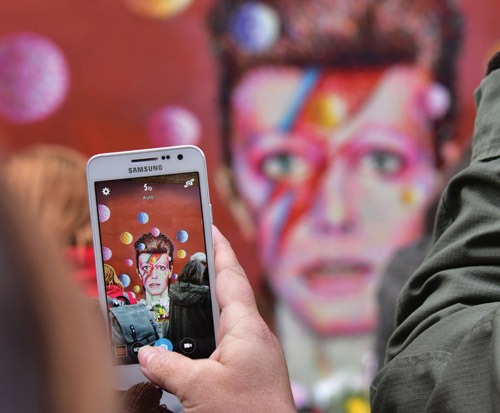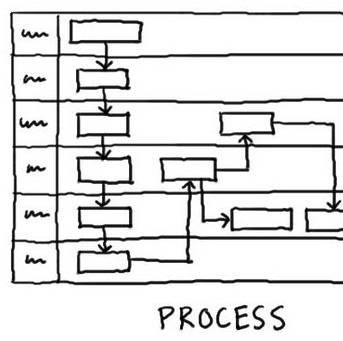
This article is a preview from the Spring 2016 edition of New Humanist. You can find out more and subscribe here.
In Wellington, New Zealand, where I live, there is a well-known piece of graffiti commemorating the death of the Joy Division vocalist Ian Curtis. Over the years, this memorial has survived various acts of casual vandalism and periodic attempts by the local council’s graffiti unit – dubbed “The Killjoy Division” – to remove it altogether. I used to walk past it quite often on my way into town, and I admit to feelings of mild amusement when “RIP” was changed to “GRIPS”, or “Walk in silence”, rather more crudely, to “Wanks in silence”. Recently, some more judicious kerning has put a stop to these practices, while for its part the council has bowed to the minor cult status of the memorial. The “Ian Curtis Memorial Wall” even has its own Facebook page now, boasting over 700 likes, and its medium-term future appears quite secure.
Existing both as an artwork that is periodically updated and restored and as a notice on Facebook’s virtual wall, this memorial neatly embraces the shifting practices around the collective grieving for artists and other famous people. The wall is a physical site, highly symbolic but also contested, and needing to be defended from time to time in order to survive. It also exists in the digital elsewhere, as a forum for people to get together and share – if not quite in mourning, given the decades that have intervened, at least in the appreciation and revival of Curtis’s art.
The sudden, unexpected death of David Bowie in January has shone a very bright light on these shifting practices. First for hours, then for a whole day, then for another, social media became a cathedral, a shared place of mourning. It was a remarkable thing to behold as, tribute after tribute, recollection after recollection, video clip after video clip, the world came together to remember one of its most beloved artists. I was largely an observer, sitting through it all without offering much by way of a contribution. Yet as a Bowie fan from a young age – thanks to a much older sister – I cherished the experience. Were it not for that outpouring, I think the event might have almost passed me by, reduced to the obituaries in the media, good and bad, and to images, perhaps, of that spontaneous party-cum-wake in Brixton. It was the shared ritual taking place on the internet that gave a unique poignancy to the moment, and made the loss more actual, more real. I had no personal connection to David Bowie the man, only to his work, which survives, yet here was a place for the sadness I felt, which I saw reflected in the sentiments expressed by others. It was a moment.
There was a backlash, because of course there was. And no, I’m not referring to the rehashing of incidents from Bowie’s past in order to question his legacy. I think there is a place for that kind of thing too, when it comes to public figures. The other backlash, which is a routine response in these circumstances, cast doubt rather on the foundations of that communal grief and on the authenticity of people’s feelings. “Grief is a delicate thing and too much internet mourning can make hypocrites of us all,” wrote Grace Dent in the Independent, calling semi-seriously for an internet moratorium following the death of any star of sufficient magnitude, while Julie Burchill pleaded in the Spectator to “spare us the sob signalling over David Bowie”. The nub of most of these critiques is that public declarations of grief for famous people, unsavoury as they are at the best of times, descend automatically into narcissistic pose as soon as they are re-routed onto social media. It’s an idea best summed up by the cutting title of a 2012 Monica Hesse piece in the Washington Post: ‘Tweet it and Weep? Online, grief over dead celebrities is really about us.’
As opposed to about whom, though? Isn’t all grief ultimately about us? Hesse went on to write, following the death of Bee Gees front man Robin Gibb, that “what was presented as genuine emotional loss sometimes looked like competitive grieving – sadness mixed with the performance art of social media”. But isn’t grieving in fact one of the most highly codified of human practices, with the strongest links to performance, since the dawn of recorded history? One need only point to the professional mourners of ancient Egyptian and Greek times, who were paid to weep and tear out their hair at funerals, a custom so common that it was briefly outlawed in Roman times, and so enduring as to have lasted in some cultures – including in my native Italy – well into the last century. We may balk at such practices for what appears to be a form of actual competitive grieving, the very definition of inauthentic feeling. But professional mourners were part of a decorum surrounding death that most of us understand. Every culture has its own taboos, its own dress codes, its own rituals. And what is a funeral, or a wake, if not an opportunity to come together and remember our loved ones, according to a precise timetable and following a delicate etiquette dictating which behaviours are appropriate and which behaviours aren’t? What is it about this rigidity that is authentic, and what is it about the messy, fluid spaces of online grieving that is artificial and wrong?
These spontaneous, temporary outpourings are connected to another distinctly contemporary phenomenon, namely the proliferation of online memorials and so-called cyber graveyards. These are largely private enterprises, many of which have gone bankrupt over the years, taking with them their supposedly ever-lasting shrines, but in some cases – notably Hong Kong’s – have become fully-fledged public institutions, allowing mourners to set up and maintain virtual memorials in place of physical ones, and reorient their grieving practices around them.
There is another side to the coming together of death and the internet, however, and it is to be found on websites like lifenaut.com or eterni.me, where the project of digital immortality – first articulated three decades ago by the likes of Hans Moravec, Ray Kurzweil and the recently deceased Marvin Minsky – finds some of its current entry points. Acting as a bridge between online memorials and “mind uploading”, eterni.me offers a platform on which not just to store personal memories but also create digital avatars for our loved ones to speak to after we are gone. These avatars are the gateway to becoming “virtually immortal”, as the website claims, or perhaps more accurately, as a CNET report wryly put it, to “Skype with the dead”.
Here the question of the authenticity of the digital other is thrown into stark relief. Who are these avatars, and to what extent could they ever be likened to us? What erasures, what drastic simplifications would have had to occur for an artificial intelligence to reach the point when they can converse like us, look like us, ultimately pass for us? These are interesting questions to entertain against the online mourning of a deceased artist, since arguably a good test of any such digital simulacrum would be its capacity not just to retrieve uploaded memories or mimic past behaviour, but show a continued capacity for creativity. In other words, a hypothetical synthetic David Bowie would have to be able to write and perform new David Bowie songs, as he himself did so close to the very end. And I personally struggle to imagine that the most sophisticated algorithms fed with the most comprehensive and faithful archive of Bowie’s work could ever come up with anything but a parody of his music: songs that may sound like his or match some of his signature styles, but not new, not living things.
Backed by the highly competitive MIT’s Entrepreneurship Development Program, eterni.me is no fringe or amateur project. Its aim, in the context of the present discussion, is not to create alternative ways of mourning but an alternative to death itself. I am comforted that we are not there yet, at the stage where carefully assembled avatars can create the illusion that a dead person isn’t truly gone, but has left a useful shadow behind. Just as I am happy that one of the most widely shared items in the days after David Bowie’s death was a graph representing the rate at which his songs were being played online, and its obvious, but nonetheless dramatic, staggering increase from the early hours of 10 January onwards. It showed that what most of us were doing most of all was the simplest, most appropriate thing: listening to his music.

